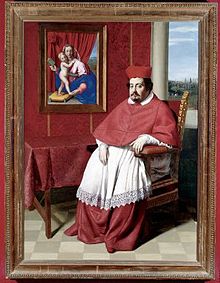Francesco Angelo Rapaccioli
Francesco Angelo Rapaccioli (* 1605 in Rome ; † May 15, 1657 ibid) was an Italian cardinal and bishop .
Life
His family is originally from Collescipoli, a small village near Terni . His father Pietro was a well-known cloth merchant with an established shop in the Piazza della Rotonda. He was second married to Ginevra Griffi and had six children with her, including Francesco, and he was in close contact with the Barberini family .
Francesco was educated at the Collegio Romano . In 1628 he dedicated his philosophical theses to Cardinal Francesco Barberini . On the feast of the Ascension of Christ in 1629 he preached in the presence of Pope Urban VIII in San Giovanni in Laterano and the sermon was published shortly afterwards, which caught the Pope's attention. Before 1631 he obtained his degree in utroque iure .
He joined the Roman Curia as a trainee lawyer for the Apostolic Signature and subsequently held various offices. In 1630 he was appointed Abbreviator des parco maggiore , in 1634 head of the Papal Chancellery , in 1636 cleric of the Apostolic Chamber , then treasurer general, president of the archives and commissioner of the papal army. He especially met and admired Josef von Copertino , who frequently visited Assisi, and the Clarissess Francesca Farnese . His special bond with the followers of Saint Vincent de Paul , to whom he was such an important patron that he received moving praise from the French priest on his death, should also be emphasized .
In the consistory of July 13, 1643 he was elevated to cardinal by Pope Urban VIII . On August 2 of the same year he was sent to Viterbo as the papal legate . On December 14th he received the titular church of Santa Maria in Via .
He took part in the conclave of 1644 , which Pope Innocent X elected, who appointed him Bishop of Terni on October 18, 1646 . The episcopal ordination took place on October 28 of the same year. Rapaccioli was characterized by his pronounced taste in art, which was reflected in an intensive patronage. He had the decoration of the cathedral completed and, thanks to the adaptation of the episcopal residence and the construction of the seminary building, gave the square in front of it the character of an “episcopal court”. A sprawling complex of buildings, expertly connected by a loggia that rests on the portico of the church and was probably inspired by the Palazzo Barberini , which the cardinal knew well because he had visited it from his youth. Thanks to the efforts of his father, Rapaccioli joined Cardinal Francesco Barberini, who became his main point of reference.
On December 21, 1650, he decided on the titular church of Santa Cecilia in Trastevere . In 1655 he took part in the conclave elected by Pope Alexander VII . In 1655 he was Pro- Camerlengo of the College of Cardinals and from 1656 to 1657 chamberlain of the Holy Cardinals College . In the meantime he had given up his diocese in 1656.
In addition to his talent as a lawyer, theologian, philosopher and Latinist, a series of essays published posthumously in the Rime heroiche collection (Rome, 1665) also recall his poetic activity.
He was a friend and great admirer of Gian Lorenzo Bernini - from whom he kept some drawings in his art collection and to whom he dedicated an artful epistle on the canopy of St. Peter's Basilica - but also of the Roman painter Michelangelo Cerquozzi and the artist Giovanni Battista Salvi from the Marken, known as Sassoferrato , painter of his portrait now in the John and Mable Ringling Museum of Art in Sarasota , Florida .
Francesco Angelo Rapaccioli died in 1657 in his Roman residence near the Capitol and was buried in the family vault in the church of Santa Maria sopra Minerva .
literature
- Giuseppe Cassio: Eccellenza del buon gusto e spirito romano. Il cardinale Francesco Angelo Rapaccioli alla corte dei Barberini . Campisano editore, Rome 2019, ISBN 978-88-98229-67-3 .
Web links
- Silvano Giordano: RAPACCIOLI, Francesco Angelo. In: Raffaele Romanelli (ed.): Dizionario Biografico degli Italiani (DBI). Volume 86: Querenghi-Rensi. Istituto della Enciclopedia Italiana, Rome 2016.
- RAPACCIOLI, Francesco Angelo. In: Salvador Miranda : The Cardinals of the Holy Roman Church. ( Florida International University website, English)
- Entry on Francesco Angelo Cardinal Rapaccioli † on catholic-hierarchy.org
- Un nuovo frammento di storia francescana: il cardinale Angelo Rapaccioli ei Cappuccini ( it ) ilcattolico.it .. Accessed April 3, 2020.
- Claudio Strinati presents G. Cassio's book on Cardinal Rapaccioli ( it ) istess.it. Accessed April 30, 2020.
Individual evidence
- ↑ cf. Gustavo Parisciani: San Giuseppe da Copertino . Osimo 1964.
- ↑ cf. A. Nicoletti: Vita della venerabile madre Suor Francesca Farnese detta di Gesù Maria dell'Ordine di S. Chiara, fondatrice delli monasterii di S. Maria delle Gratie di Farnese e della Ss. Concettione di Albano e di Roma e riformatrice del monasterio di S. Maria degli Angeli di Palestrina . Rome 1660, p. 437 ( google.it ).
| predecessor | Office | successor |
|---|---|---|
| Ippolito Andreassi |
Bishop of Terni 1646–1656 |
Sebastiano Gentili |
| personal data | |
|---|---|
| SURNAME | Rapaccioli, Francesco Angelo |
| BRIEF DESCRIPTION | Cardinal and bishop |
| DATE OF BIRTH | 1605 |
| PLACE OF BIRTH | Rome |
| DATE OF DEATH | May 15, 1657 |
| Place of death | Rome |
